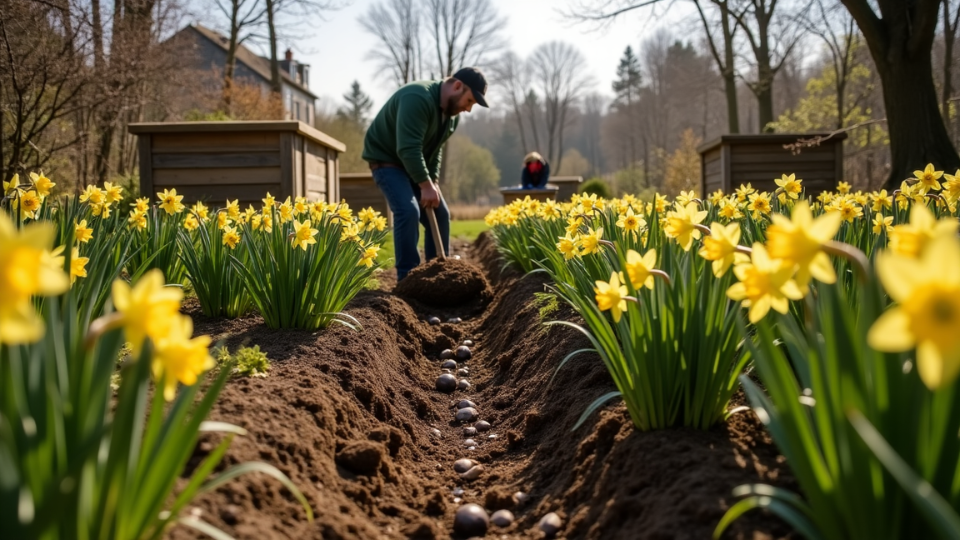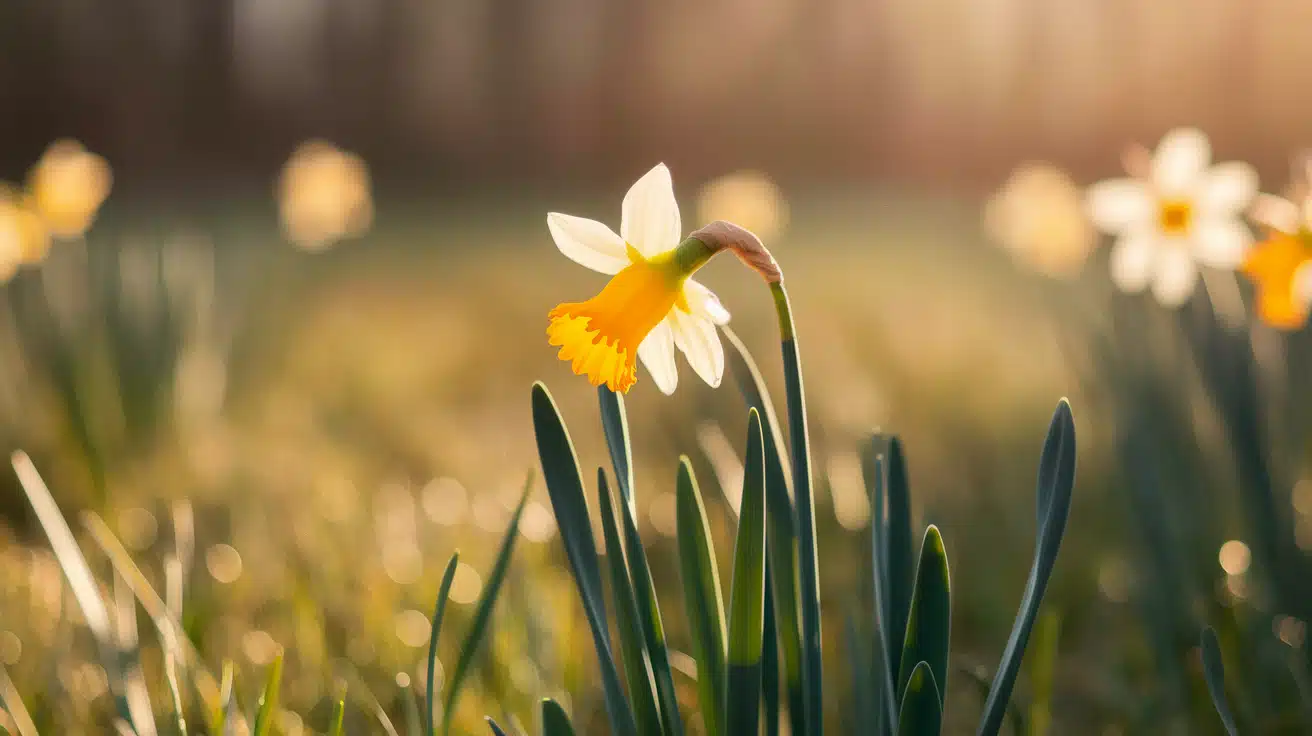Nothing frustrates gardeners more than daffodils that produce beautiful green leaves but refuse to bloom. You planted these bulbs expecting bright spring flowers, yet year after year, you get only foliage. If you’ve wondered “why have my daffodils come up blind,” you’re not alone.
The good news is that daffodil blindness can be fixed and prevented with simple care techniques. Most blind bulbs aren’t dead; they need the right conditions to flower again.
This guide explains exactly what causes daffodils to go blind and gives you proven solutions to restore their blooms. You’ll learn how to spot the warning signs, fix current problems, and prevent blindness from happening again.
From proper feeding to correct planting depth, we’ll cover everything you need to bring back those cheerful spring flowers to your garden.
What is Daffodil Blindness?
Daffodil blindness occurs when bulbs produce healthy green leaves but fail to produce flowers. The term describes bulbs that “go blind,” meaning they lose their ability to bloom.
This problem affects many spring bulbs, not just daffodils. Tulips, crocuses, and hyacinths can also experience blindness. It’s one of the most common issues gardeners face with flowering bulbs.
Daffodil blindness is not a disease or infection. It’s a condition caused by environmental factors and poor growing conditions. The bulbs are still alive and healthy; they need better care to bloom again.
Many gardeners mistakenly think their bulbs are dead when they see leaves without flowers. However, with proper treatment, blind daffodils can usually recover and flower again.
Key Signs of Daffodil Blindness
Understanding the symptoms of daffodil blindness is the first step in restoring blooms. Here are the most common signs
- Presence of Lush Green Foliage with No Blooms – Your daffodils produce normal-looking leaves, but zero flowers appear in spring.
- Reduced Flowering Over the Years – Each year brings fewer blooms until your daffodils stop flowering completely.
- Weak or Stunted Leaf Growth in Severe Cases – Leaves look thin, short, or pale instead of their usual thick green appearance.
- Late or Irregular Emergence – Some bulbs emerge weeks later than others or fail to emerge at all.
- Floppy or Limp Foliage – Leaves bend over and can’t stand upright without flower stems to support them.
- Sparse or Uneven Clump Density – Your once-full daffodil patches now have bare spots where bulbs have failed.
What Causes Daffodil Bulbs to Fail to Bloom?

There are several reasons why daffodil bulbs come up blind. Daffodil bulbs may fail to bloom due to overcrowding, insufficient sunlight, or nutrient-poor soil. Cutting foliage too early or stress from drought or pests can also prevent flowering. These environmental conditions—along with incorrect planting—often explain why daffodils fail to produce blooms despite vigorous foliage.
1. Insufficient Sunlight
Daffodil leaves need at least 6 weeks of full sun after blooming to feed the bulb. When trees leaf out or structures block light, the bulbs can’t store enough energy. Without adequate sunlight, bulbs become weak and skip flowering the following year.
This is why daffodils under deciduous trees often go blind over time.
2. Overcrowding
When daffodil clumps become too dense, bulbs compete for the same nutrients and space. Each bulb gets less food and water, making them too weak to produce flowers. Overcrowded bulbs also create smaller offset bulbs that may never reach flowering size.
This problem gets worse each year as more bulbs form in the same spot.
3. Poor Soil Nutrition
Daffodils need potassium to form flower buds for next year’s blooms. Soil that lacks nutrients, particularly potassium, prevents bulbs from storing enough energy.
Poor drainage also washes away vital nutrients before bulbs can absorb them. Without proper feeding, bulbs focus on survival rather than flower production.
4. Premature Removal of Foliage
Cutting daffodil leaves too early stops the bulb from building energy reserves. The green leaves continue to undergo photosynthesis for 6 to 8 weeks after the flowers fade.
When gardeners mow or cut leaves before they yellow naturally, bulbs can’t prepare for next year. This single mistake often causes blindness in the following spring.
5. Incorrect Planting Depth
Shallow planting exposes bulbs to temperature swings and drying out. Deep planting makes it hard for shoots to reach the surface and flowers to form.
For most daffodils, the correct planting depth is 2-3 times the bulb’s height. The wrong planting depth stresses bulbs and reduces their ability to bloom reliably.
6. Pest and Disease
Bulb flies lay eggs near daffodils, and their larvae eat the bulb centers. Fungal rot from wet conditions weakens or kills bulbs before they can flower.
Slugs and snails also damage emerging shoots and leaves. These pests and diseases drain the bulb’s energy, preventing normal flower development.
7. Immature or Damaged Bulbs
Small offset bulbs need 2-3 years to reach flowering size. Bulbs damaged during digging or storage may never recover fully. Poor-quality bulbs from unreliable sources often fail to establish a proper connection. Young or damaged bulbs allocate their energy to root growth rather than flower production.
8. Drought or Waterlogging
Bulbs need consistent but not excessive moisture during their summer rest period. Severe drought prevents bulbs from developing properly for next year’s growth.
Waterlogged soil causes bulb rot and prevents normal development cycles. Both extremes stress bulbs and significantly reduce their flowering potential.
How to Fix Daffodil Blindness?

Here are some ways to fix daffodil blindness: improve planting conditions, ensure proper care, and address environmental factors. These steps help restore reliable daffodil flowering.
- Allow foliage to die back naturally – Let leaves turn yellow and wither for 6-8 weeks after flowering to rebuild bulb energy.
- Feed with a high-potash fertilizer – Apply tomato fertilizer in early spring when shoots emerge to boost flower formation.
- Dig up and divide clumps – Lift overcrowded bulbs every 3-5 years and replant with proper spacing.
- Replant bulbs at correct depth – Plant bulbs 2-3 times their height deep for optimal growth and flowering.
- Improve soil drainage – Add compost or move bulbs to raised beds if the soil stays waterlogged.
- Remove and discard diseased bulbs – Throw away any soft, moldy, or damaged bulbs to prevent the spread of problems.
How to Prevent Daffodil Blindness?
To prevent daffodil blindness, plant in full sun, ensure well-drained soil, avoid overcrowding, allow foliage to die back naturally, and feed with a high-potash fertilizer.
| Action | Why It’s Important |
|---|---|
| Plant in full sun | Daffodils need sunlight to recharge bulbs. |
| Use well-drained soil | Prevents bulb rot and poor growth. |
| Leave leaves until fully yellowed | Foliage feeds the bulb for next year’s blooms. |
| Feed with potash-rich fertilizer | Supports strong flower development. |
| Divide crowded clumps every few years | Overcrowding reduces flowering. |
| Deadhead spent blooms | Prevents energy loss to seed production. |
Should You Replace Blind Daffodils?
Replace blind daffodils only after trying revival methods for 2-3 seasons without success. If bulbs show signs of disease, damage, or produce extremely weak foliage, buying new ones is more cost-effective than waiting years for recovery.
Quality bulbs from reputable suppliers cost less than the time and effort spent on severely declining clumps. However, most blind daffodils can be revived with proper care, making replacement unnecessary in most cases.
Before buying new bulbs, fix the underlying soil and growing conditions that caused the original blindness, or your new daffodils will face the same problems.
Daffodil Blindness vs. Other Flowering Issues
Here’s how daffodil blindness compares to other flowering issues: it’s mainly caused by planting or environmental factors, unlike pests or diseases.
| Issue | Symptoms | When | Cause | Fix |
|---|---|---|---|---|
| Blindness | Leaves grow, no flowers | Spring | Too crowded, poor care | Divide bulbs, feed, and don’t cut leaves too early |
| Bulb Rot | Bulbs are soft, smell bad, no shoots | Spring/dormancy | Wet soil, fungus, or bacteria | Remove bad bulbs, fix drainage, and avoid too much water |
| Frost Damage | Leaf tips black, buds die or deform | Late winter/spring | Cold after growth starts | Cover shoots, plant bulbs deeper |
| Nutrient Deficiency | Yellow leaves, few flowers | Spring | Not enough potassium or balance | Use fertilizer early in growth |
| Dormancy | No leaves or flowers | Summer to winter | Normal rest after bloom | Leave bulbs in place, don’t dig up |
Final Thoughts
Daffodil blindness is a common but fixable problem that affects many spring gardens. The primary causes include overcrowding, inadequate nutrition, insufficient sunlight, and harvesting leaves too early.
With proper care, most blind daffodils can bloom again.
Remember these key steps: let foliage die back naturally for 6-8 weeks, feed with high-potash fertilizer in spring, and divide overcrowded clumps every 3-5 years. Plant bulbs at the correct depth and ensure good soil drainage for best results.
With consistent care and patience, your daffodils will reward you with abundant spring blooms for years to come.
Start implementing these fixes this season, and you’ll see healthier, more reliable flowering next spring. Your garden deserves those bright yellow flowers that signal the end of winter.
What daffodil problems are you dealing with in your garden?
Frequently Asked Questions
Can Blind Daffodils Flower Again?
Yes, most blind daffodils can bloom again with proper care and patience within one to two years.
What is the Superstition About Daffodils?
In some cultures, daffodils symbolize renewal, good fortune, and the arrival of spring; however, they’re also believed to bring bad luck if given as a gift.
What Other Spring Bulbs Suffer from Blindness?
Tulips, crocuses, hyacinths, and alliums can all experience the same flowering problems as daffodils.














